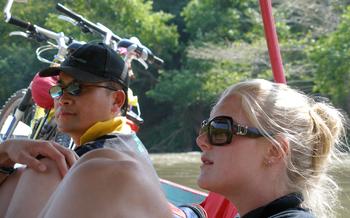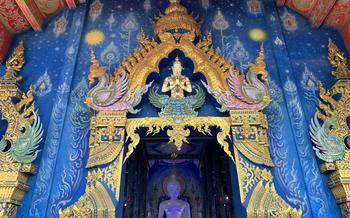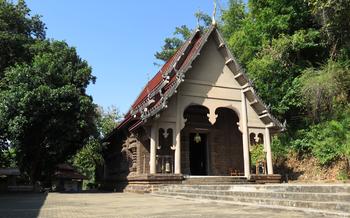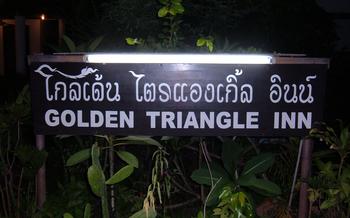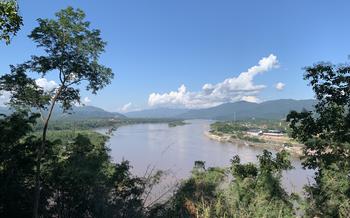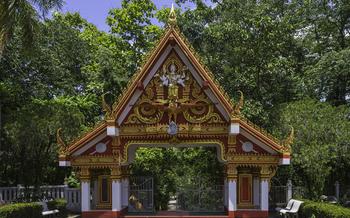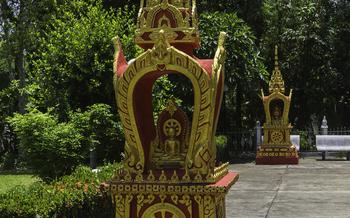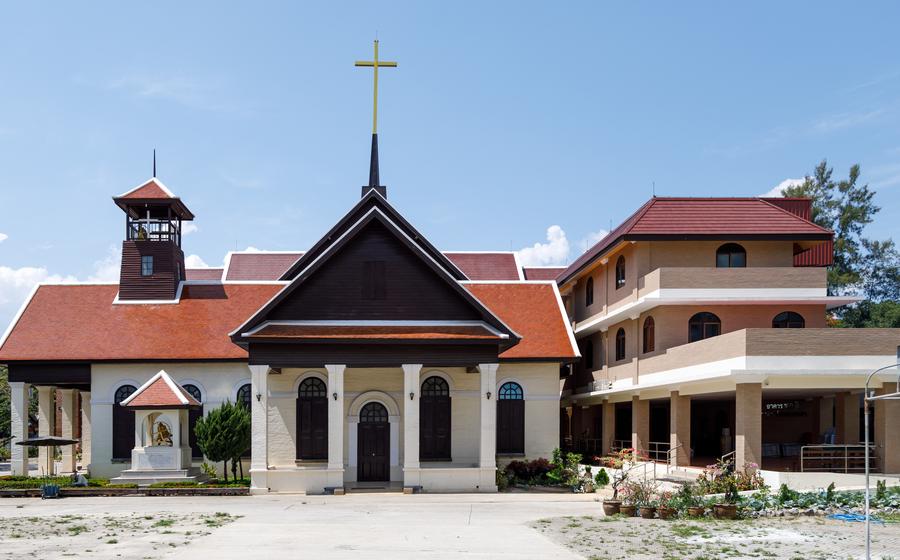
Hall of Opium Museum
- Golden Triangle Views:
- Educational Programs
- Souvenir Shopping
- Cultural Performances
- Local Cuisine
- Photography Opportunities
- Accessibility
- Visitor Information
Golden Triangle Views:
The Hall of Opium Museum offers breathtaking views of the Golden Triangle, a region where the borders of Thailand, Myanmar, and Laos converge. The museum's observation deck provides a panoramic vista of the lush green valleys, rolling hills, and meandering rivers that characterize this scenic landscape. From this vantage point, visitors can admire the confluence of the Mekong and Ruak rivers, two of the most important waterways in Southeast Asia. The natural beauty of the region is simply stunning, and the observation deck provides an ideal opportunity to capture some truly memorable photographs.
Educational Programs
The Hall of Opium Museum offers a range of educational programs and workshops to deepen visitors' understanding of the complex issues surrounding opium. These programs are led by experts in the field of opium research and policy, providing participants with valuable insights and knowledge.
One of the most popular programs is the "Opium and Society" workshop, which explores the social, economic, and environmental consequences of opium use. Participants learn about the history of opium cultivation and trade, the impact of opium wars on the region, and the challenges faced by opium-affected communities.
Another popular program is the "Opium Science" workshop, which delves into the science behind opium production and its effects on the human body. Participants learn about the chemistry of opium, its medicinal properties, and the risks associated with its use.
These educational programs are an excellent opportunity for visitors to gain a deeper understanding of the complexities of the opium issue and its impact on Thailand and the wider region. They are suitable for students, researchers, policymakers, and anyone interested in learning more about this fascinating and important topic.
Souvenir Shopping
At the Hall of Opium Museum, you'll find a unique opportunity to support local artisans and contribute to the community's economic development by purchasing souvenirs and handicrafts from the museum's gift shop. From intricately carved wooden sculptures to colorful hand-woven textiles, the gift shop offers a wide range of authentic and locally made products.
One of the highlights of the gift shop is the selection of opium-themed souvenirs. You'll find everything from opium pipes and jewelry to books and postcards, all beautifully crafted and designed to commemorate your visit to this fascinating museum.
Whether you're looking for a unique gift for a loved one or a special memento to remember your time in Chiang Rai, the Hall of Opium Museum's gift shop is the perfect place to find something truly special. So be sure to set aside some time to browse the shop and support the local community while you're there.
Cultural Performances
Immerse yourself in the vibrant tapestry of Thai culture through captivating performances at the Hall of Opium Museum's amphitheater. Experience the rhythmic beats of traditional music, the graceful movements of dancers adorned in intricate costumes, and the enchanting melodies of folk songs. These performances offer a glimpse into the rich cultural heritage of Chiang Rai and provide a deeper understanding of the region's traditions and way of life.
As the curtains rise, be mesmerized by the skillful movements of Thai dancers as they narrate stories through their elegant gestures and expressions. The harmonious blend of music and dance creates a captivating spectacle that transports you to another era. The vibrant colors of the costumes, the intricate choreography, and the infectious energy of the performers leave an unforgettable impression.
Take this opportunity to learn about the diverse ethnic groups that call Chiang Rai home, each with its own unique cultural expressions. Witness the rhythmic beats of the Akha drums, the soulful melodies of the Hmong flute, and the enchanting dances of the Lisu people. These performances celebrate the cultural diversity of the region and offer a glimpse into the lives of the people who have shaped its history.
Indulge in the richness of Thai culture and traditions at the Hall of Opium Museum's amphitheater. Let the vibrant performances transport you to a world of enchantment and leave you with cherished memories of your time in Chiang Rai.
Local Cuisine
Indulge in a culinary journey at the Hall of Opium Museum's restaurant, where you can savor the tantalizing flavors of traditional Thai cuisine. Delight your palate with regional specialties such as khao soi, a rich and creamy curry noodle soup; sai ua, a flavorful northern Thai sausage; and nam prik ong, a spicy chili paste served with fresh vegetables. Experience the unique blend of herbs, spices, and textures that define Chiang Rai's culinary heritage. As you savor each bite, immerse yourself in the vibrant atmosphere of the restaurant, adorned with traditional Thai décor and offering stunning views of the surrounding landscape. Whether you're a foodie or simply seeking an authentic Thai dining experience, the Hall of Opium Museum's restaurant is a must-visit destination.
Photography Opportunities
The Hall of Opium Museum presents a treasure trove of photographic opportunities for visitors. The striking architecture of the museum, blending traditional Lanna elements with modern design, creates a captivating backdrop for capturing unique shots. Inside the museum, the interactive exhibits and displays offer subjects that are both visually appealing and educational. From intricate opium pipes to vintage photographs and maps, there are countless opportunities to capture the essence of the museum's collection.
Additionally, the museum's surroundings offer stunning views of the Golden Triangle region. The observation deck provides a panoramic vista of the Mekong and Ruak rivers, where visitors can capture breathtaking shots of the natural beauty of the region. The lush greenery, rolling hills, and picturesque villages create a stunning backdrop for landscape photography.
For photography enthusiasts, the Hall of Opium Museum is a paradise. With its diverse range of subjects and stunning surroundings, the museum offers ample opportunities to capture memorable images that will serve as lasting reminders of a visit to this unique and fascinating place.
Accessibility
The Hall of Opium Museum is committed to providing an accessible and inclusive experience for all visitors. The museum features a range of accessibility features to ensure that everyone can enjoy and learn from its exhibits.
Wheelchair access is available throughout the museum, with ramps and elevators connecting the different levels. Accessible restrooms are also available for the convenience of visitors with disabilities.
The museum staff is trained to assist visitors with disabilities and can provide additional assistance as needed. Visitors with specific accessibility requirements are encouraged to contact the museum in advance to make arrangements.
By providing these accessibility features, the Hall of Opium Museum ensures that everyone has the opportunity to learn about the history and impact of opium in Thailand and the Golden Triangle.
Visitor Information
To ensure a smooth and enjoyable museum experience, plan your visit by checking the museum's website or contacting them directly for the most up-to-date information on hours of operation, admission fees, and guided tour schedules.
The Hall of Opium Museum offers guided tours that provide a deeper insight into the history and significance of the exhibits. Booking a tour in advance is recommended, especially during peak tourist season.
Admission fees are typically charged, and there may be additional costs for guided tours or special programs. Consider purchasing a combination ticket that includes other attractions in the area for a more comprehensive and cost-effective experience.
Plan to spend at least two to three hours at the museum to fully appreciate the exhibits and immerse yourself in the opium trail experience. Remember to bring comfortable shoes as there is a significant amount of walking involved.
The museum is committed to providing an accessible and inclusive experience for all visitors. Wheelchair access, ramps, and elevators are available throughout the museum, ensuring that everyone can explore and learn about the history of opium.
For further assistance or inquiries, do not hesitate to approach the friendly and knowledgeable staff at the museum. They are always ready to help make your visit as informative and enjoyable as possible.
